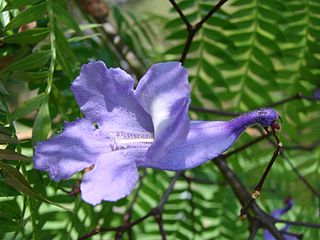
Jacaranda is a genus of 49 species of flowering plants in the family Bignoniaceae, native to tropical and subtropical regions of Latin America and the Caribbean.

Fraxinus latifolia, the Oregon ash, is a member of the ash genus Fraxinus, native to western North America.

Hakea bucculenta, commonly known as red pokers, is a large shrub in the family Proteaceae endemic to Western Australia. A spectacular ornamental shrub with red or orange flowers that appear in rod-like blooms in leaf axils for an extended period from May to November.

Erythrina vespertilio is a tree native to north and north-east Australia. Its common names are grey corkwood, bat's wing coral tree, yulbah and the more ambiguous "bean tree". In the Western Desert language it is also known as ininti.
Cardwellia is a genus of a sole described species of large trees in the plant family Proteaceae. The species Cardwellia sublimis is endemic to the rainforests of the wet tropics region of northeastern Queensland, Australia. Other common names include bull oak, golden spanglewood, lacewood, oak and oongaary. The compound leaves have up to 17 leaflets. It produces white inflorescences followed by woody fruits which are prominently displayed outside the canopy.

Hakea clavata, commonly known as coastal hakea is a shrub that is endemic to an area along the south coast of Western Australia. It has thick leaves, pink and grey flowers and grows on rocky outcrops.

Arytera distylis, known as the two-leaved coogera or twin-leaved coogera is a rainforest tree of eastern Australia. It grows by streams or in sea side rainforests. It occurs from the Orara River in the Mid North Coast region of New South Wales, extending up to Maryborough in south east Queensland.

Atalaya multiflora, known as the broad leaved whitewood, is a rare and endangered rainforest tree of the soapberry family native to eastern Australia.

Hakea commutata is a shrub in the family Proteaceae native to Western Australia. A variable species in shape and growing requirements, including mallee heath, sand and along creek lines.

Hakea adnata is a shrub in the family Proteaceae native to the south coast of Western Australia. It is multi-stemmed shrub that produces masses of white scented flowers from late winter to spring.
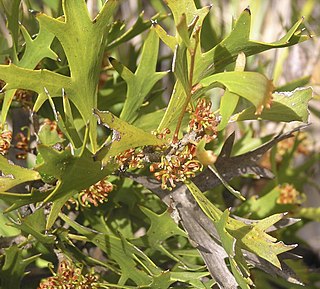
Hakea ceratophylla, commonly known as the horned leaf hakea, is a shrub in the family) Proteaceae and is endemic to the southwest of Western Australia. It is a stiff shrub with variably-shaped leaves that are sometimes lobed and flowers with white or rusty-coloured hairs.

Hakea elliptica, commonly known as the oval-leaf hakea, is a shrub in the family Proteacea and is endemic to Western Australia. A fast growing adaptable species with ornamental wavy leaves, golden bronze new growth and an abundance of showy white flowers. A good wildlife habitat due to its dense form with foliage to ground level.
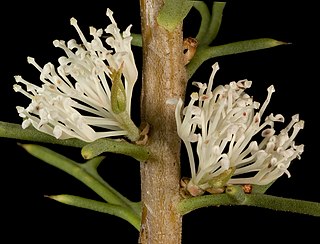
Hakea varia, commonly known as the variable-leaved hakea, is a shrub of the family Proteacea and endemic to Wheatbelt, South West, Great Southern and Goldfields-Esperance regions of Western Australia. It is a dense prickly shrub with creamy-white or yellow flowers and variable shaped leaves.

Hakea loranthifolia is a shrub of the family Proteaceae and is endemic to Western Australia. It has an open growth habit, stiff egg-shaped leaves with longitudinal veins, smooth grey bark and white flowers from July to September.
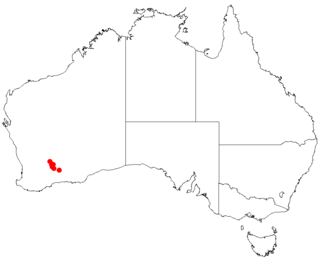
Hakea pendens is a shrub of the genus Hakea native to a small area in the Goldfields-Esperance regions of Western Australia.
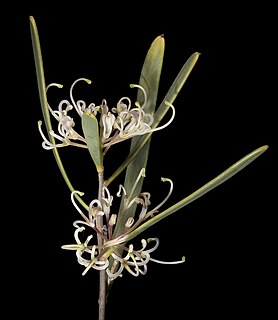
Hakea stenophylla is a shrub or tree in the family Proteacea, with sweetly scented creamy-white flowers. It is endemic to Western Australia.
Acacia argentina is a species of Acacia native to eastern Australia.
Jacaranda caerulea is a flowering tree belonging to the genus Jacaranda. It is native to the West Indies, including Cuba and the Bahamas.
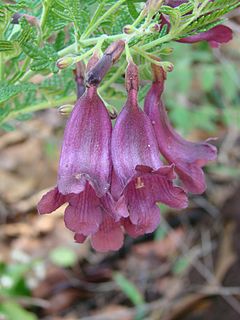
Jacaranda ulei is a flowering tree native to the Cerrado region of Brazil. It was first described by Édouard Bureau and Karl Moritz Schumann in 1897.
Butia catarinensis is a mid-sized species of Butia palm native to the states of Rio Grande do Sul, Santa Catarina in Brazil.















